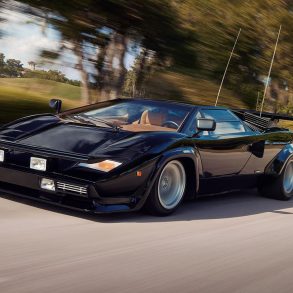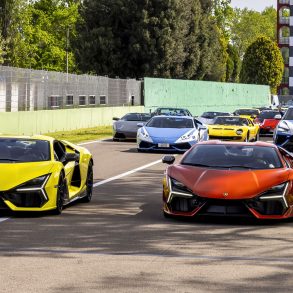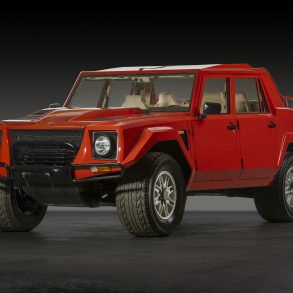In 1966, when the stunning Lamborghini Miura debuted at the Geneva Auto Show, it shook the automotive industry. The car’s sleek, muscular lines and an engine positioned mid-mounted was influenced by the motorsports world but was something never seen before in road cars.
The pièce de résistance was the intriguing transverse, mid-mounted V12 engine in the vehicle. Not only did this provide a profoundly beautiful silhouette, but it also provided the Miura incredible balance and weight distribution. The vehicle became the world’s first supercar and set the scene for contemporary hypercars of today.
1969 – The Italian Job
History Leading up to the Miura
Ferruccio Elio Arturo Lamborghini was born on April 28, 1916, to grape farmers Antonio and Evelina Lamborghini in Renazzo di Cento, Italy. As he grew up, young Ferruccio was drawn more to the mechanics of farming machinery instead of the farming lifestyle of his parents.
After WW2, Ferruccio recognized there was an emerging market for agricultural machinery and began to build “Carioca” tractors from engine and differential parts from 6-cylinder Morris trucks that the British forces left in Italy when they left to return home.

With gasoline prohibitively expensive, he built a unique fuel automizer that allowed his new tractors to be started with gas and then switched over to cheaper diesel fuel. The new Carioca tractors began selling so phonemically well that Ferruccio decided to officially found a new company, Lamborghini Trattori, so he could manufacture as many tractors as he could to satisfy the demand.
With the continued success of his “Carioca” tractors, Lamborghini’s increased wealth allowed him to purchase more expensive and faster cars.
Included in Lamborghini’s collection of vehicles were two Ferraris, a white one for his personal use, and a black one for his wife. Even though he thought his Ferrari cars were good, he believed they were too noisy and rough to be proper road cars, more suited to be sold as track vehicles instead.
Lamborghini also found the Ferrari vehicles had inferior clutches. He often needed to make trips to Maranello to have his Ferraris repaired because of clutch problems. Also, in his spare time, he discovered he was able to modify one of his personal Ferrari 250 GTs so that it outperformed regular stock models.

When he met Enzo Ferrari to discuss the issues with his Ferraris, he complained to the mighty “il Commendatore” about using cheap, commercial products. Displeased, Enzo suggested he should stick to agricultural equipment.
The exchange would inspire Ferruccio to produce his own high-performance Grand Touring cars.
Prototype 350 GTV
The first Lamborghini vehicle, prototype 350 GTV, was designed by Franco Scaglione, an impressive designer who had provided designs for Fiat, Jaguar, and Alfa-Romeo in the past, along with Ferrari. Once the design was finalized it was built by Carrozzeria Sargiotto in Turin. It was built quickly, in only four months, so it could be presented at the Turin Motor Show in October 1963. Unfortunately, the new 350 GTV received a generally mediocre response from the motoring press.

The 350 GT and 400GT
The 350 GT, Lamborghini’s first production car, debuted at the 1964 Geneva Motor Show and received positive reviews from the press. By the end of the year, Lamborghini had sold 13 of the new vehicles. Unfortunately, each car was sold at a loss to stay competitive with the Ferraris of the time. The 350 GT would remain in production for two years with a total of 120 vehicles being sold.

For the next version of the vehicle, the company stretched the 350 GT to add two smaller seats in the rear to create the 400 GT 2+2. The new version had a larger Bizzarrini V12 engine, slightly different roofline, and featured minor sheet metal changes. The 400 GT 2+2 was introduced at the Geneva Auto Show on 10 March 1966 and received impressive reviews.

Miura P400- Transformation of the Sports Car
The next vehicle Lamborghini would release was to be earth-shattering and disrupt the design of sports cars. Instead of producing a front-engined vehicle, the design would incorporate an engine mounted behind the driver, similar to formula 1 race cars of their time, but nothing that was seen in road vehicles. An illustration of the trending popularity of the mid-engine concept could be seen at the 1965 Le Mans, with several cars sporting the mid-engine placement including the Ford GT40s, Porsche 904s, Ferrari 330 P2s, and 250/275 LMs.
The concept of a mid-engined road car was not popular at the time with Enzo Ferrari as he was dubious that customers had the skills required to keep mid-engined vehicles on the road safely.
The young team at Lamborghini though had no reservations about creating a mid-mounted engine for the road. Three youth within the Lamborghini team spearheaded the design which included: Gian Paolo Dallara, a 26-year-old aeronautical engineering graduate, Paolo Stanzani, a 27-year-old engineer, and Bob Wallace, a 27-year-old New-Zealand-born development driver. They began working on the design of a prototype 2-seater they envisioned as a new road car for enthusiasts that could also compete on the track.

Dallara and Stanzani designed a novel steel tub chassis that could place Bizzarrini’s V12 engine immediately behind the driver transversely. They took inspiration from the Lola GT and the Austin Mini.
They delayed bringing their idea up to Ferruccio’s attention believing that such a vehicle would probably be too expensive, and would likely distract focus from the company’s objectives. Ferruccio had a strict no-racing stance. In fact, he wrote a policy in the company’s bylaws prohibiting racing, wanting to avoid the expensive development required to compete with Ford and Ferrari at Le Mans.
When they finally mentioned the idea to Lamborghini, he allowed the three to go ahead with the project, known internally as the P400, believing it might be useful if for nothing more than as a potential marketing tool.
1965 Turin Motor Show
The rolling chassis of the P400 with a transverse mid-engine layout was introduced in November at the 1965 Turin Motor Show. The Dallara’s sheet-steel monocoque chassis featured ‘Swiss cheese’ holes for lightness.

The chassis attracted enormous interest because of the radical transverse engine layout and generated a buzz surrounding the mystery of the final product.
Body Design
Following the Turin show, Ferruccio tapped Nuccio Bertone for the role of the body design. The initial sketches were performed by Giorgetto Giugiaro, however, on leaving the firm, 25-year-old Marcello Gandini completed the work.



The Miura body was low-slung with a sweeping body running from the shark nose to the tail. A large and curved windscreen rose to the roof that stood only 1050 mm from the ground.
Even though the Miura prototypes had a plexiglass screen overlying the engine, issues with ventilation and visibility required Gandini to invent a chic set of louvers that kept the rain out while maintaining rear vision.
Air intakes were drawn in from the rocker panels to cool the rear brakes along with from behind the doors providing air to the engine’s four Weber carburetors.
A clamshell-opening aluminum front hood and rear engine cover enabled easier and fast access to the vehicle’s mechanical parts.

Twin-circular headlamps, sourced from Fiat 850 Spider, were recessed flush with the nose to reduce drag. They were surrounded by Miuras signature ‘eyelashes’, an air intake for the front brakes.

Interior
Within the interior located immediately in front of the driver on the dashboard is a prominent speedometer to the left and tachometer on the right, while auxiliary gauges and switches are located in the hooded center stack that protrudes from the middle of the dashboard.


Engine
The Bizzarrini-designed quad-cam 3929cc V12 was utilized from the 400GT (revised 350GT with a larger engine). The output was able to be increased from 320hp to 350hp largely due to an increased compression ratio and the upright positioning of carburetors. The fuel delivery was via four triple choke Weber 40 IDL3C carburetors.

The V12 engine was positioned transversely directly behind the driver and was inspired by the likes of the Austin Mini and the Lola GT. With the engine sitting directly behind the two seats, the driver and passenger could experience the throaty exhaust notes of the V12.

The Miura engine and transmission were cast as one piece, with both the transmission and the engine sharing the same oil. Towards the end of 1971 about 96 SV variants were built with a split sump, which separated the engine and gearbox oils.
Breeder of Spanish Fighting Bulls
Lamborghini had decided to name the vehicle, Miura, after his long-time friend, Don Eduardo Miura, a renowned breeder of Spanish fighting bulls in Seville, Spain. Don Eduardo was reportedly filled with pride when he learned that his friend, Ferruccio, had named a car in honor of his family and their line of prized bulls.
1966 Geneva Motor Show
In March 1966, the P400 (“P” for Posteriore and 400 for four liters) featured a new body that had been finished only a few days earlier prior to the 1966 Geneva Motor Show. Unfortunately, the engineers had failed to check if the huge V12 powerplant would fit inside the Miura engine bay. As a result, the team reportedly filled the engine bay with ballast and kept journalists away from the engine.

Lamborghini’s new P400 Miura became the highlight of the entire event, completely overshadowing the debut of Ferrari’s new 330GTC. Every manufacturer from Aston Martin to Ferrari looked out-of-date by comparison. Lamborghini had now positioned itself as a dominant player in the world of sports cars.
Keeping the momentum of the excitement of the P400 displayed in Geneva, Lamborghini brought the Miura to the Monte Carlo Grand Prix, recognizing that it was a haven for the most enthusiastic car lovers. He parked an Orange Miura in front of Hotel de Paris on a Saturday afternoon and intrigued so many onlookers that the square in front of the Casino became totally obstructed.

Lamborghini Miura Prototypes
Prior to the first production Miura on 20 April 1967, the company produced five developmental prototypes to use as testing and show cars, being chassis 0502, 0862, 0706, 0961, and 0979.
The first three vehicles featured counter-clockwise crankshaft rotation which was converted to clockwise with the fourth car by introducing an idler gear. The first three of the vehicles also featured pop-out roof-mounted vents that were abandoned due to rainwater leaking issues.
The first four of the cars featured a slightly lower roofline that was ultimately raised by vehicle number five to give the car some extra needed headroom.
Lamborghini Miura P400
The P400 at its time was the fastest car in the world with a top speed of 163 mph and a 0-60 time of 6.3 seconds.
Although the P400 Miura was a game-changer for the automotive industry, it did have some issues reported.
A number of drivers bemoaned of excess chassis flex and dilemmas with the skinny tires. The vehicle also developed instability at high speeds due to aerodynamic lift. These difficulties led to Lamborghini producing a number of improvements to the Miura over its production life.

In total, approximately 474 Lamborghini P400 Miura were produced (Joe Sackey’s book, The Miura Bible)
Valuation of the 1968 Lamborghini Miura P400
| Condition | Value |
|---|---|
| Concours | $1,100,000 |
| Excellent | $880,000 |
| Good | $815,000 |
| Fair | $740,000 |
Lamborghini Miura P400 S
The Lamborghini Miura P400 S was released at the Turin Motor Show in 1968. Cosmetically, the P400 S received a higher-quality interior trim and the instrument layout was revised along with power windows. Other upgrades included optional air conditioning and a lockable glove box.





The vehicle shared the same potent transverse V12 engine and Bertone-designed body from the earlier car. The engine was upgraded though to produce 370 bhp (an additional 20 horsepower) due to the addition of higher-lift camshafts with revised timings and the fitment of four Weber 40IDL-3L carburetors.
To avoid flexing at high cornering speeds, Lamborghini used a heavier-gauge steel on the chassis.
At 168 mph, the Miura S was the fastest road car ever tested by Road & Track magazine, which in 1970 they dubbed it “an exercise in automotive art for a particularly rapturous kind of driving.”
Around 140 vehicles were produced (Joe Sackey’s book, The Miura Bible) until Lamborghini replaced the model with the “SV” version in March 1971.
Valuation of the 1969 Lamborghini Miura P400 S
| Condition | Value |
|---|---|
| Concours | $1,450,000 |
| Excellent | $1,200,000 |
| Good | $1,100,000 |
| Fair | $1,000,000 |
*Note +25% for vented disc brakes / +10% for factory air conditioning
Lamborghini Miura SV
Introduced in 1971, the Miura SV (Spinto Veloce), also known as the P400 SV, is considered by many to be the finest Miura made by Lamborghini and being the last iteration, was the most developed.
The suspension was revised somewhat to assist in reducing the “front-end lightness” that defined the handling of earlier versions, and the rear bodywork was widened by 13cm for a more assertive stance.


Wider Pirelli Cinturato 255VR-15 tires were also fitted on larger Campagnolo cast magnesium wheels.
At the front of the vehicle, the surrounding ‘eyelashes’ of the headlights were removed, leaving a smooth headlight surrounds.

The chassis itself was made more rigid to meet the demands of the more powerful 385 hp at 7850 rpm. The engine was fitted with larger carburetors and it featured a different cam timing, helping to make the SV more user-friendly at lower RPMs. As mentioned previously, after 1971 approximately 94 cars had a split sump so the engine and transmission oil were separate.
When the SV was released it could outrun just about everything on the road with its top speed being 180mph and an acceleration from 0–60 mph in just 5.8 seconds.

In total, 150 Lamborghini Miura P400 SV were produced from 1971 to 1973.
Valuation of the 1972 Lamborghini Miura P400 SV
| Condition | Value |
|---|---|
| Concours | $2,200,000 |
| Excellent | $1,950,000 |
| Good | $1,750,000 |
| Fair | $1,550,000 |
Lamborghini Miura Roadster
Only one factory-built Miura Roadster was created for the 1968 Brussels motor show featuring a redesigned body by Bertone. The vehicle featured large side-mounted air intakes, a lowered roofline, a heavily raked windscreen, and the rear section was completely redesigned (rear louvers covering the engine were removed to display the 394hp engine, tail lights changed and exhaust pipes exited from lower grill).

Bertone strengthened the chassis of the Miura to prevent the car from flexing given there was no roof. The exterior was painted in a bright-metallic azure blue shade, while inside the car it was upholstered in a magnolia dye leather.
Despite the Roadster being well-received at the Brussels show, Lamborghini declined all requests for a production car.
In 1969, the International Lead and Zinc Research Corporation (ILZRO), purchased the car from Lamborghini to showcase their technology. Many original parts were replaced with zinc alternatives. The vehicle was additionally resprayed green after which it toured the world at various auto shows.

In 2006 the Roadster commenced a comprehensive restoration to return the Roadster to its 1968 Brussels Salon original. After a two year process, the Roadster was shown in the original 1968 livery at the 2008 Pebble Beach Concours d’Elegance.
Ferruccio Lamborghini’s incredibly beautiful and powerful Miuras radical layout set the scene for future sports cars. With Gandini’s fresh new astonishing body and sleek lines, the vehicle became the standard for mid-engine 2-seat high-performance sports cars, a standard that continues to this day.











“The vehicle became the world’s first supercar and set the scene for contemporary hypercars of today.”
world’s first supercar was Alfa Romeo Stradale 33